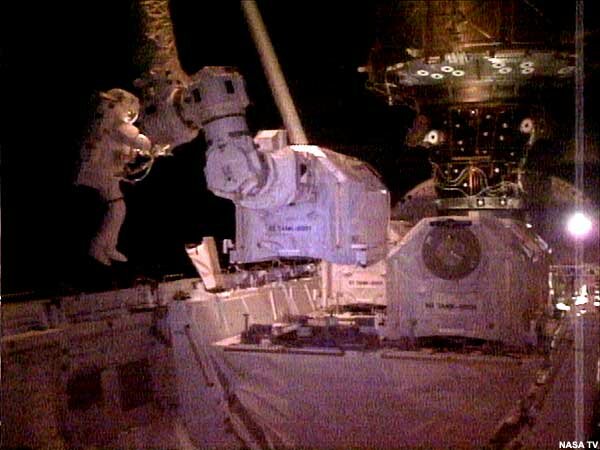Challenge:
Home
News Archive
Forums
CPMA
Maps
Smackdown2
People
Coverage
Features
Interviews
Links
Help Wanted
Columns:
Hosted
3.A.C
Interfaced
QWF

Affiliates:
Cached
Methos
Killer Instincts
Saturday, 21 July 2001 -
Watching the Space Man ? $comment_count ?>
If you're quick, you can still catch some live coverage from NASA of the current Shuttle and International Space Station (ISS) mission at NASATV. You'll find all sorts of goodies available in their Realdata section, and of course if you hunt around a bit you will find much more.
I've been watching some of this stuff over the past few days and it makes for some "reality TV" with a difference. The 56 kbps stream is good enough to run in the background while I do other things and I can hear the NASA commentator from the next room. There is a handy schedule too, and I'm looking forward to checking out the landing.

airlock. The Shuttle is pointing out to space, hence you
can't see the view he can see, of the Earth behind the
camera. The robotic arm is carrying one of the
pressurised gas tanks needed for the airlock.
What they've been doing in this mission is attaching an airlock to the ISS which will enable then to exit the ISS wearing US spacesuits (currently they either have to wear Russian suits and exit the Russian module or they have to use a docked Shuttle). To attach it they need to use two robotic arms (one on the ISS and one on the shuttle) and two space-walkers. The first spacewalk (EVA - Extra Vehicular Activity) was to attach the airlock itself (Quest). In the second they attached some Oxygen and Nitrogen tanks to the Quest airlock. In the third, which is just starting now as I type this, they will exit the airlock (rather than the shuttle) to attach the final tanks. That way, I guess, the guys installing it are the first ones who have to test it, which will make them concentrate on getting it right first time.
In other "space news", on Wednesday I got up before sunrise and drove half an hour or so down the coast to see a rare line-up of heavenly bodies from a lookout bluff overloooking the ocean (looking east). The heavenly bodies were (looking from top to bottom) Saturn, Venus, the crescent Moon, Jupiter, and Mercury. They were all lined up and it looked kind of spooky, but that may have been because I was the only person on that clifftop in the dark. Right now is also a good time to see Mars in the sky as it's just passed very close to earth.
If you've seen that stupid program which put the "case" that the Apollo moon landings were all faked, you'll know that one of the "pieces of evidence" given was that there were no stars visible in any of the photos taken on the moon. Guess what, you can't see any stars in the live coverage from the many cameras on the Shuttle or ISS either. The reason, if you stop to think about it, is because in order to capture the stars the cameras would have to over-expose the foreground images. I can still remember in 1969 being woken up by my dad to watch Neil Armstrong walk on the moon on a grainy black and white TV.
Comments
| The universe is big. | |
| Comment #1 by on 02:05, Saturday, 21 July 2001 | 130.130.68.19 |
| Thanks for the links Hoony. On the subject of dodgy space realism, anyone seen "Tomb Raider"? |
|
| Comment #2 by on 10:18, Saturday, 21 July 2001 | 217.3.237.8 |
| /me is having a good time listening to Monster Magnet - Space Lord Didn't know you wanted to be a Silver Surfer, Hoony :-) |
|
| Moon landing hoax | |
| Comment #4 by on 21:50, Friday, 10 August 2001 | 171.64.72.149 |
| Here's a fun website that sarcastically destroys the hoax theories: http://www.redzero.demon.co.uk/moonhoax/ |
|